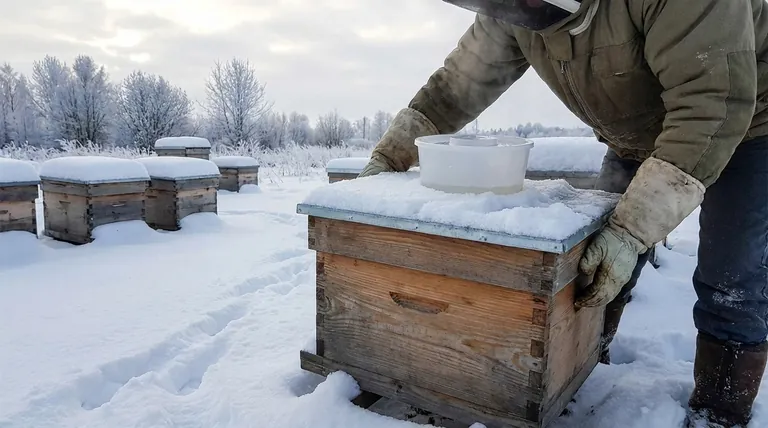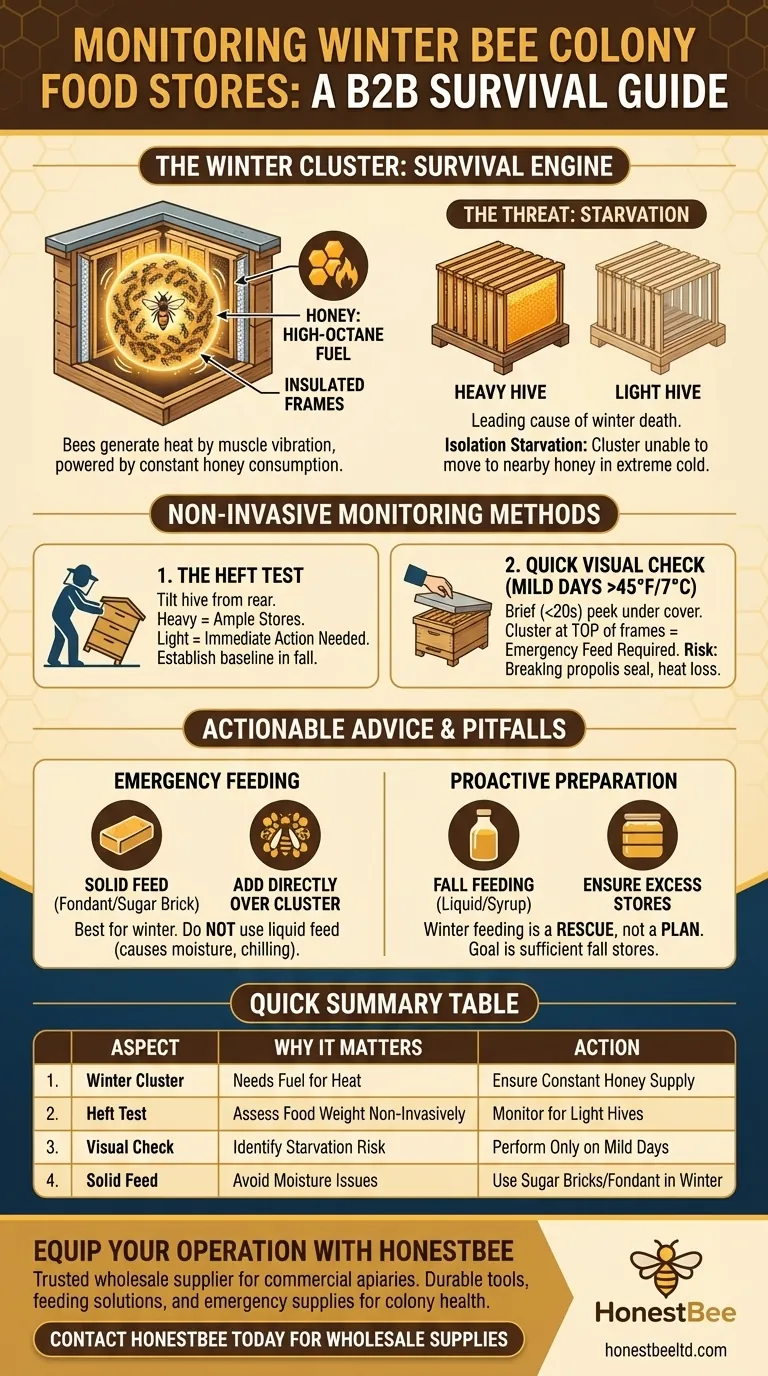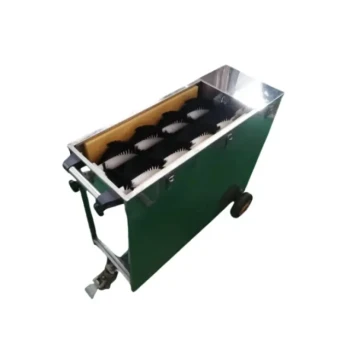In beekeeping, winter is not a time of rest—it is the ultimate test of survival. Monitoring your colony's food stores is the single most critical task during this period because starvation is the leading, and most preventable, cause of winter death. Without a constant supply of energy from honey, a colony cannot generate the heat required to survive the cold, and it will perish.
Your role as a beekeeper shifts in winter from a manager of production to a guardian of survival. The core task is not just to see if bees have food, but to ensure they have an uninterrupted supply to fuel their winter cluster, the living engine that stands between the colony and the cold.

The Winter Cluster: A Bee's Survival Engine
To understand why monitoring is so vital, you must first understand the metabolic miracle of the winter cluster. Bees do not heat the entire hive; they only heat their cluster.
How a Winter Cluster Works
Bees form a tight, basketball-sized sphere around the queen. The bees on the outer layer of this sphere act as a living blanket, insulating the colony from the cold.
Inside the cluster, bees vibrate their powerful wing muscles without moving their wings. This constant muscular activity generates an incredible amount of heat, keeping the center of the cluster at a stable, warm temperature, even when it is freezing outside.
Honey as High-Octane Fuel
This heat generation is an intensely energy-demanding process. Honey is the high-carbohydrate, high-energy fuel that powers it.
A colony will methodically consume its stored honey throughout the winter. They typically start at the bottom of the hive and slowly eat their way upwards as the months progress. A lack of this fuel means the "engine" stalls, the cluster cannot generate heat, and the bees freeze.
The Danger of Isolation Starvation
A colony can starve to death even with frames of honey just a few inches away. This is known as isolation starvation.
If a sudden, severe cold snap occurs, the cluster may be unable or unwilling to break its formation to move to adjacent frames of honey. They become a "frozen island" in a "sea of plenty" and starve in place. This highlights the importance of having a large, robust colony and continuous food stores.
Methods for Monitoring Food Stores
Opening a hive in winter is risky, as it breaks the propolis seal the bees created to keep out drafts and can fatally chill the colony. Therefore, non-invasive or minimally invasive methods are preferred.
The Heft Test (Non-Invasive)
This is the most common and effective technique. Approach the hive from the back and carefully tilt it forward by lifting the rear.
A heavy hive is a reassuring sign of ample food stores. A hive that feels surprisingly light is a major red flag that the colony is running low on food and requires immediate attention. Practice this in the fall on a full hive to get a baseline feel.
A Quick Visual Inspection (Minimally Invasive)
On a mild, sunny winter day (above 45-50°F / 7-10°C), you can perform a very quick check. Do not remove any frames.
Simply lift the outer and inner cover for no more than 10-20 seconds. If you see the bee cluster at the very top of the frames, it means they have consumed all the stores below them. They are at high risk of starving and need emergency food.
Understanding the Trade-offs and Pitfalls
Intervention is a balance between providing aid and causing harm. Understanding the risks is key to making the right decision.
The Problem with Liquid Feed
Never feed bees liquid sugar syrup in the dead of winter. The bees cannot properly process it in the cold.
Worse, the excess moisture from the syrup can condense inside the hive, creating a cold, damp environment that is a death sentence for the colony. Liquid feed is for fall preparation, not winter emergencies.
The Risk of Opening the Hive
Every time you open the hive, you break the vital propolis seal and release precious heat. A quick check is sometimes necessary, but prolonged inspections are dangerous.
Your goal is to gain the necessary information in seconds, not minutes. Be prepared with your tools and any emergency feed before you crack the lid.
Emergency Feeding vs. Fall Preparation
The absolute best practice is to ensure your colonies have more than enough honey stores before winter begins. Winter feeding should be viewed as an emergency rescue, not a standard part of your plan. Relying on it indicates that fall preparations were insufficient.
Making the Right Choice for Your Colony
Your strategy should be tailored to your colony's specific situation and your management philosophy.
- If your primary focus is proactive, low-intervention beekeeping: Ensure hives are exceptionally heavy with honey in the fall and rely on periodic heft tests through winter to monitor consumption.
- If you discover a light hive mid-winter: Perform a quick visual check on the next mild day. If the cluster is at the top, immediately provide a solid emergency food source like a sugar brick or fondant directly over the cluster.
- If you are planning for an early spring buildup: Consider adding a pollen patty in late winter (February/March in most northern climates), but only if you are certain the colony has abundant honey stores to fuel the resulting brood production.
Proactive monitoring transforms winter from a period of anxiety into a manageable challenge, ensuring you act as a prepared steward for your colony's health.
Summary Table:
| Key Monitoring Aspect | Why It Matters |
|---|---|
| Winter Cluster Heat Generation | Bees need honey to fuel heat production; starvation is the leading cause of winter death. |
| Isolation Starvation Risk | Bees can starve with honey nearby if cold prevents cluster movement. |
| Heft Test (Non-Invasive) | Quickly assess food weight; a light hive signals immediate need for action. |
| Quick Visual Check (Mild Days) | Inspect cluster position; top-frame clusters indicate emergency feeding is required. |
| Avoid Liquid Feed in Winter | Liquid sugar causes moisture buildup and chilling; use solid alternatives like sugar bricks. |
Ensure your apiary thrives through winter with reliable beekeeping supplies from HONESTBEE.
As a trusted wholesale supplier for commercial apiaries and beekeeping equipment distributors, we provide the durable tools and feeding solutions you need to monitor and support your colonies effectively. From hive hefting aids to emergency fondant, our products are designed for beekeepers who prioritize colony health and survival.
Don’t leave winter survival to chance—contact HONESTBEE today to equip your operation with professional-grade supplies tailored for cold-weather success.
Visual Guide

Related Products
- Rapid Bee Feeder White Plastic 2L Round Top Feeder for 8 or 10-Frame Bee Hives
- HONESTBEE Entrance Bee Feeder Professional Hive Nutrition Solution for Beekeeping
- HONESTBEE Professional Entrance Bee Feeder Hive Nutrition Solution
- HONESTBEE Round Hive Top Bee Feeder for Syrup
- HONESTBEE Entrance Bee Feeder Efficient Hive Front Liquid Feeding Solution for Beekeeping
People Also Ask
- How much honey does a strong hive need to survive winter? Ensure Your Colony's Survival (60-80 lbs)
- Can you dilute honey and feed it to the bees? Understand the Critical Risks and Safe Practices
- What is the best thing to feed bees? A Guide to Supplemental Feeding for a Thriving Hive
- What can the round hive top feeder be used for? A Guide to Efficient, Safe Bee Feeding
- What is the advice regarding feeding bees to limit brood production based on? Managing Prolific Bee Strains



















